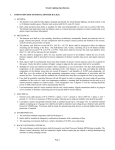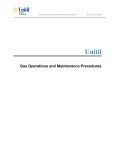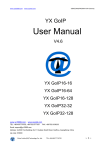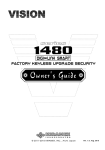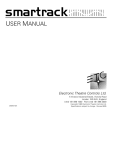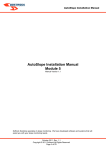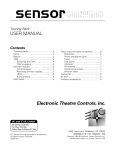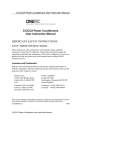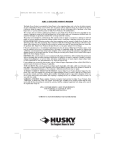Download CD80 Supervisor Rolling Rack Specification
Transcript
I. Strand Lighting Specification CD80 SUPERVISOR ROLLING DIMMER RACK(S) A. GENERAL 1. The dimmer racks shall be fully digital, designed specifically for entertainment lighting touring applications. Each full size rack shall consist of up to 48 dimmer module spaces. Compact racks shall consist of up to 24 module spaces. Dimmer rack systems shall be UL and cUL listed. 2. Rack setup and preset data shall be fully user programmable on a per rack or system wide basis. The dimmer rack shall report rack and dimmer status to a remote personal computer or control console and, as an option, report load status information. B. MECHANICAL 1. The dimmer rack shall be a free standing, dead-front switchboard, substantially framed and enclosed with formed steel panels. All rack components shall be properly treated, primed and finished in fine texture, scratch resistant, two tone gray and black powder coat paint. Four swivel heavy duty casters shall be provided to facilitate rack movement and handling, Integral heavy duty handles shall also be provided. Large racks shall have fork lift guides and mounting for lifting eyes. 2. The dimmer rack shall not exceed 60”H x 50.75”W x 32.25”D. Racks shall be designed to permit three racks to fit across the width of a trailer. The compact dimmer rack version, consisting of up to 24 dimmer module spaces shall not exceed 60”H x 26.5”W x 32.25”D. Drop in covers shall be provided to protect all components and shall fit flush with the frame of the rack. 3. The rack shall be designed to allow for easy insertion and removal of all modules without the use of tools. Dimmer supports shall be provided for precise alignment of dimmer modules into power and signal connector blocks. 4. Rack spaces shall be mechanically keyed such that modules of greater current capacity cannot be accepted for that space. Racks that allow modules of higher wattage to plug into the same space shall not be acceptable. 5. Multiple low-noise fans shall be provided to allow redundancy in case of fan failure. The fans shall maintain the temperature of all components at proper operating levels with dimmers at any load, providing the ambient temperature of the dimmer room does not exceed 40 degrees C. Air shall flow over the surfaces of the heat generating components using a combination of convection and fan assisted air flow. 6. Fans shall be gradually controlled between off and full speed in order to minimize fan noise under all operating conditions. In the event of a rack over temperature condition, a warning shall be displayed on the rack LCD display or on a remote personal computer or control system. If the temperature rises 5 degrees C over the warning threshold, power to SSR control circuits will be automatically shut off. 7. Load wiring shall be terminated in either stage pin connectors of an appropriate rating or multi-circuit veam or socapex connectors (20 amp dimmers) or a combination of both as specified on each rack model. All plug bays shall be illuminated by dimmable worklights. Test points and hot pockets shall be provided on all racks. 8. A storage bay shall be provided to store spare dimmer modules, electronics modules, or miscellaneous equipment. The bay shall have a hinged latching cover. 9. A load patch shall be available to connect load connectors to dimmers on 20 amp dimmer racks.. Patch cords shall have extra flexible cables and “stackable’ connectors to pemit patching multiple circuits to a single dimmer. Hot patch points and “patch cable parking” slots shall be provided with each patch bay. The patch bay shall have a hinged latching cover and include a dimmed worklight. C. ELECTRICAL 1. Dimmer racks shall operate at 100 to 240VAC 3 phase, 4 wire + ground with a variety of power input connector options including Camlock, Abbott or Posilock panels. 2. Main breakers shall be available as an option on all models. 3. Indicators shall be provided adjacent to the power input connectors to show that power has been applied to each phase in the rack. Page 1 Strand Lighting Specification D. RACK ELECTRONICS, PHYSICAL 1. The main dimmer control electronics shall be housed in one Rack Processor Module (RPM) plug in module. The dimmer control electronics shall be completely digital without employing any digital to analog demultiplexing schemes or analog ramping circuits. 2. All rack setup and preset data shall be stored in a non-volatile manner and may be transferred to a replacement Rack Processor Module without losing data. 3. Each Rack Processor Module shall have a back-lit LCD display with a six key keypad for rack setup, preset control, testing, rack status, error and diagnostics. Six LED’s shall indicate mux inputs A and B OK, electronics power OK, processor OK (Built In Self Test), active processor, and dimmer module error. 4. All rack setup and preset data shall be transferable to and from library storage on a personal computer on a per rack or system wide basis. 5. A permanently mounted Central Interconnection Card (CIC) shall provide signal connections and security features in conjunction with optional rack mounted power supply units. The CIC shall provide the only point for contractor connection of signal cables and PANIC activation. The connections shall be made with two part plugin screw terminals for ease of contracting. 6. All digital multiplex, RS-485 communication ports and remote contact input connections shall be optically isolated from all processor electronics by 2,500V RMS isolation. 7. The Central Interconnection Card shall have the provision to select any of a maximum of 96 dimmer to be activated by a PANIC function. The PANIC function shall be activated or de-activated by one or more local or remote contact closures. The CIC shall provide a selection device to enable or disable the activation of PANIC when removing the RPM from an active rack. PANIC will not be automatically activated if a RPM is removed from an inactive rack. Racks that employ processor controlled PANIC functions shall not be acceptable. 8. The CIC shall have LED’s indicating: a. +5V for opto-isolation OK. b. Auxiliary power supply OK. c. PANIC active. d. Rack overheat warning. e. Power phases active. E. RACK ELECTRONICS, CONTROL AND COMMUNICATIONS 1. The control electronics shall provide the following control and communication inputs as standard: a. Two optically isolated DMX512 control inputs. The first input can be AMX192 as an alternative to DMX512. The second input is DMX512 only. Each mux input shall have a patch to allow overlapping or separation of any mux control level. All inputs shall include daisy chain connectors for interconnection to other racks. b. RS-485 optically isolated signal inputs for System Wide Control (SWC). SWC is separate from the mux control signal, allowing sophisticated and independent remote control of circuits and presets through a hand held programmer and/or preset stations. c. One RS485 optically isolated link for Rack Reporter functions either a console or a Reporter PC. This link may be daisy chained from rack to rack with the connectors mounted on the rack. d. One RS-232 signal input for local connection to a personal computer, providing setup, playback, library storage and reporter feature supervision. 2. The control electronics shall provide the following outputs as standard: a. Up to 96 phase controlled signals to control the dimmer SSRs. F. RACK ELECTRONICS, FEATURES 1. The dimmer control electronics shall have a dimmer update rate better than 16 ms (60 Hz) or 20 ms (50 Hz). Dimmer outputs shall exhibit no oscillating or hunting for levels. Dimmers set to the same level shall output within +/-1V of each other, regardless of phase or input voltage, providing the desired level is less than the phase input voltage less the dimmer insertion voltage. 2. The dimmer output levels shall be regulated for incoming line voltage variations. The regulation shall adjust for both RMS voltage and frequency changes of the incoming AC wave form. Regulation shall maintain the desired output voltage +/- 1 volt for the entire operation range (100 - 240VAC) with the exception that the maximum Page 2 Strand Lighting Specification 3. 4. 5. 6. 7. 8. output will be no greater than the phase input voltage less the dimmer insertion voltage. The regulation shall compensate for variations of the AC waveform on a dimmer-by-dimmer basis. There shall be no interaction between dimmers in the system or any other equipment. The output shall be regulated to the user programmable maximum voltage level on a dimmer-by-dimmer basis between 50V and 240V. The processor response time to incoming line changes shall take no more than 16 ms (60 Hz) or 20 ms (50 Hz). Dimming systems that do not respond to line voltage and frequency variations shall not be acceptable. The control electronics shall allow the maximum output levels of individual dimmers to be adjusted, e.g. to compensate for load circuit voltage loss. The selected dimmer curve shall regulate so that the curve is proportional to the programmed maximum voltage. Systems with status reporting dimmers shall have full line compensation with adjustment for changes in line and load, systems without this capability shall not be accepted. The RPM shall also have the capability to support dimmers of different types and sizes that may be mixed throughout the rack. Individual dimmers may be dimmed or switched (non-dim). The individual phase control or switching of positive and negative line voltage half cycles shall not be acceptable, as the net resultant DC line current may damage or degrade line supply transformers. The control electronics shall contain diagnostic routines to perform a self test (Built In Self Test). Standard status reporting shall consist of: a. Dimmer type in slot (user programmed data). b. Input line voltage per phase. c. Mux A input fail. d. Mux B input fail. e. Dimmer output level (%). f. Rack overheat warning. g. Rack overheat shut-down. Optional load status reporting shall consist of the following on a per dimmer basis: a. Load (Wattage). b. Deviation from recorded load. c. No load. d. Excess DC. e. Overload. f. SSR failure. g. Circuit breaker open. h. Dimmer fault. The control electronics shall provide the following setup functions that shall be user programmable on a per rack or system wide basis: a. Mux A patch. b. Mux B patch. c. Analog inputs patch. d. Architectural patch for Outlook control systems. e. Set rack circuit ID. f. Dimmer report enable/disable. g. Record preset and preset crossfade time. h. Set SWC preset. i. Set SWC backup preset. j. Set architectural preset with Outlook control systems. k. Set dimmer level (%). l. Set dimmer max. voltage (50V - 250V in 1V steps). m. Set dimmer min. level (0 to 99%). n. Set dimmer curve. o. Set dimmer response time. p. Set control logic. The mux A and B patching shall support a rack start address and individual dimmer patch. It shall be possible to patch the analog outputs to any mux A and B address. The architectural patch shall define the rack circuit / room / room channel relationship for Outlook control systems. Page 3 Strand Lighting Specification 9. Each individual rack circuit shall have a 5-digit alphanumeric ID (Circuit ID) that is addressable by a personal computer connection or by SWC (SWC can access the first 4 digits), enabling continuous numbering over several mux spans or enabling other user programmable groupings or labeling. 10. The control electronics shall provide a facility to disable the output of any individual dimmer by setting the level to 0. It shall also be possible to enable and disable dimmer status reporting on a per dimmer basis. 11. The control electronics shall contain 99 System Wide Control (SWC) user programmable presets and a permanent blackout preset (preset 0). It shall be possible to record individual preset crossfade times, including preset 0. The presets shall be simply user programmable as a snapshot of the current dimmer outputs resulting from all dimmer control sources according to selected control logic, on a per rack or system wide basis. Each preset may have an individual crossfade time between 0 seconds and 10 minutes. 12. The control electronics shall support a user assignable backup preset. Each rack shall, in the event of loss of mux control according to selected control logic, maintain the last levels for a user programmable period after which it shall automatically fade in the assigned backup preset. Alternatively it shall be possible to program the rack to indefinitely hold the last dimmer levels. Systems that do not offer this feature shall not be acceptable. It shall be possible to continue control without an active mux signal using any of the SWC or Outlook architectural presets as well as the analog inputs. 13. The control electronics shall provide the ability to set one or a group of dimmers to any level. 14. The control electronics shall provide the ability to set a library or user programmable curve to any individual dimmer. Library curves shall be: a. Square curve. b. S-curve. c. Linear power output curve. 15. User selectable curves shall be: a. Non-dim (switched) with a programmable trigger level 0 - 99%. b. Electronic ballast fluorescent curve with a kick-start voltage and user programmable top set and bottom cutoff point. c. Magnetic ballast fluorescent curve with user programmable top set and bottom cut-off point. d. Five user defined programmable curves. 16. Each dimmer shall have one of three user programmable response in order to optimize lamp filament life and speed of operation: a. Fast (30 ms). b. Normal (100 ms). c. Slow (300 ms). 17. The control electronics shall provide a number of user programmable control logic schemes, regulating the logical relationship between dimmer control sources: a. Mux A highest takes precedence (HTP) with mux B, plus HTP with SWC presets. b. Mux A only HTP with SWC presets. c. Mux B only HTP with SWC presets. d. Mux A over mux B. e. Mux A or mux B only HTP with SWC presets (A or B mux selection via external contact closure). f. Mux B over mux A HTP with SWC presets. G. DIMMER PERIPHERAL EQUIPMENT 1. The dimmer system shall support the following range of specialized peripherals: a. Remote SWC hand held programmers. b. Remote personal computer for user programming, library storage of dimmer setup data and remote monitoring of dimmer and load status. c. Remote console monitoring of status reporting dimmers 2. The dimmer system shall support a remote hand held SWC Programmer unit with 40 tactile keys and a 4 line by 16 character backlit LCD offering channel control using standard control system syntax and direct action level keys, preset and preset time recording and control and riggers functions Check+, Check- and Rem Dim. The SWC programmer shall be functional with distributed dimming systems in conjunction with other SWC panels Page 4 Strand Lighting Specification and shall not require the presence of a control system to function. Dimming systems that do not offer this facility shall not be acceptable. Connectors shall be provided on each rack to permit daisy chaining the SWC data link. II. DIMMER MODULES A. GENERAL 1. The dimmer modules shall be designed using advanced, state-of-the-art components specifically for entertainment lighting. B. PHYSICAL 1. The dimmer modules shall be fully plug in and factory wired. Dimmer modules shall be of rugged and heavy duty construction enclosed by a formed aluminum chassis. Power and signal pins shall be recessed in a self aligning housing to avoid handling, storage, and insertion damage. A contoured handle shall be provided for ease of insertion and withdrawal. All chassis parts, except heat sinks, shall be properly treated, primed and finished in fine texture, scratch resistant, gray powder coat paint. Each module shall be labeled with the manufacturer’s name, catalog number and rating. Modules constructed of molded plastic for structural support shall not be acceptable. Dimmer modules shall be UL and cUL recognized devices. 2. Dimmer modules shall be keyed so that dimmer modules of greater capacity shall not be interchangeable. 3. Standard factory modules shall be available to provide dedicated non-dim circuits not employing SSR devices. Dual modules shall be available providing non-dim/dimmer, dimmer/non-dim and non-dim/non-dim configurations. Each non-dim shall be provided with a primary circuit breaker of the appropriate rating. Nondims shall be designed so they can be used for inductive loads. 4. Standard factory modules shall be available to provide hard fired output for use with neon, cold cathode, and fluorescent loads. Hard Fired modules shall provide a current source independent of the load current for the SCR Gate Drive Signal. Hard fired dimmers shall function independent of load as a result and shall drive loads of 1 watt or less. Systems without this capability shall not be accepted. C. ELECTRICAL 1. Each dimmer module shall contain one or two single pole circuit breakers, associated solid state switching modules, filters, power and control components. 2. Dimmer electronics shall be completely solid state. They shall utilize two silicon controlled rectifiers in a backto-back electrical configuration. The full load of the circuit is to be carried and controlled by the silicon controlled rectifiers. 3. Each dimmer shall be protected by a fully magnetic circuit breaker of the appropriate current rating and 10,000 AIC surge rating mounted on the face plate of the dimmer module so that the trip current is not affected by ambient or rack temperature. The circuit breaker shall be rated for tungsten loads having an inrush rating of no less than 20 times normal current and shall disconnect the power to the dimmer module before damage can be done to the dimmer power components. The circuit breakers shall be rated for 100 percent switching duty applications and shall be a UL and cUL recognized device. D. SOLID STATE RELAY (SSR) 1. SSR devices shall be encapsulated, epoxy filled high impact plastic cases with optically isolated firing circuits, control circuitry, and two silicon controlled rectifiers (SCRs). There shall be a minimum of 2,500 volts RMS of isolation between the AC line and the control lines of the SSR. 2. The SCR shall be in an industry standard format that is easily field replaceable without removing any other electrical or electronic devices. E. FILTERING 1. Each dimmer module shall have an integral inductive filter to reduce the rate of current rise time resulting from the SCR switching on. The filter shall limit objectionable harmonics, reduce lamp filament sing and limit the radio frequency interference on line and load conductors. 2. Type (i) dimmers shall have a rise time of not less than 350 microseconds measured at 90 degrees conduction angle from 10% to 90% of output wave form with dimmer operating at maximum load. Voltage rate of rise (slew rate) must not exceed 420 millivolts per microsecond in any point of the wave under full load conditions. Page 5 Strand Lighting Specification 3. Type (ii) dimmers shall have a rise time of not less than 500 microseconds measured at 90 degrees conduction angle from 10% to 90% of output wave form with dimmer operating at maximum load. Voltage rate of rise (slew rate) must not exceed 300 millivolts per microsecond in any point of the wave under full load conditions. 4. Type (iii) dimmers shall have a rise time of not less than 800 microseconds measured at 90 degrees conduction angle from 10% to 90% of output wave form with dimmer operating at maximum load. Voltage rate of rise (slew rate) must not exceed 210 millivolts per microsecond in any point of the wave under full load conditions. 5. The use of type i, ii, or iii dimmers shall not reduce rack density. 2.4kW and 6.0kW modules are available as types i, ii, or iii. 12.0kW modules are available as type i. F. PERFORMANCE 1. The dimmer module shall be capable of "hot patching" cold, incandescent loads up to its full rated capacity without malfunction with the control signal at full ON. 2. The dimmer power efficiency shall be at least 97% at full load with a no load loss of 3V RMS for type i dimmers. G. ROLLING RACK, INCLUDED FURNISHINGS 1. Rolling dimmer rack, spaces for dimmer modules based on model specified 2. Single processor electronics module (dual processors available as custom) 3. Drop in covers H. PROVIDE THE FOLLOWING: Qty. Cat. No. Disc. 2.4kW Racks # 75056 # 75057 # 75058 # 75059 # 75060 # 75061 # 75062 Compact 48 X 2.4 kW rack, 48 -20A GP connectors and 8 - 6 cct Socapex connectors Compact 48 X 2.4 kW rack, 48 -20A GP connectors and 8 - 6 cct Socapex connectors and Main Breaker Compact 48 X 2.4 kW rack, 96 -20A GP connectors and 8 - 6 cct Socapex connectors Compact 48 X 2.4 kW rack, 48 -20A GP connectors and 16 - 6 cct Socapex connectors Full size 96 X 2.4 kW rack, 96 -20A GP connectors, 16 - 6 cct Socapex connectors, 192 cct Patch Bay Full size 96 X 2.4 kW rack, 96 -20A GP connectors, 16 - 12 cct Veam connectors, 192 cct Patch Bay, Main Breaker Compact 48 X 2.4 kW rack, 48 -20A GP connectors , 16 - 6 cct Socapex connectors, 144 cct patch Bay 6.0 kW Racks # 75053 # 75054 # 75055 Full Size 48 X 6.0 kW rack, 48 - 50A GP connectors Compact 24 X 6.0 kW rack, 24 - 50A GP connectors Compact 24 X 6.0 kW rack, 24 - 50A GP connectors and Main Brkr 12.0 kW Racks # 75050 # 75051 # 75052 Full Size 48 X 12.0 kW rack, 48 - 100A GP connectors Compact 24 X 12.0 kW rack, 24 - 100A GP connectors Compact 24 X 12.0 kW rack, 24 - 100A GP connectors and Main Brkr CD80SV Standard Dimmer Modules -120V # 72314 2.4kW dual CD80SV standard FF dimmer module with primary circuit breakers and 350µs toroidal choke (120V) # 72315 2.4kW dual CD80SV standard FF dimmer module with primary circuit breakers and 500µs toroidal choke (120V) # 72316 2.4kW dual CD80SV standard FF dimmer module with primary circuit breakers and 800µs toroidal choke (120V) # 72318 2.4kW dual CD80SV standard HF dimmer module with primary circuit breakers and 350µs toroidal choke (120V) # 72382 2.4kW CD80SV standard FF dimmer/non-dim module with primary circuit breakers (120V) Page 6 Strand Lighting Specification # 72384 2.4kW CD80SV standard FF non-dim/dimmer module with primary circuit breakers (120V) 2.4kW CD80SV standard FF dual non-dim module with primary circuit breakers (120V) # 72386 # 72302 CD80SV dual constant module ( 2 - 20 ampere ) (120V) # 72354 # 72356 1.8kW dual CD80SV standard FF dimmer module with primary circuit breakers and 300µs toroidal choke (120V) 1.8kW dual CD80SV standard FF dimmer module with primary circuit breakers and 450µs toroidal choke (120V) # 72324 # 72325 # 72326 # 72332 6.0kW CD80SV standard FF dimmer module with primary circuit breaker and 350µs toroidal choke (120V) 6.0kW CD80SV standard FF dimmer module with primary circuit breaker and 500µs toroidal choke (120V) 6.0kW CD80SV standard FF dimmer module with primary circuit breaker and 800µs toroidal choke (120V) 12.0kW CD80SV standard FF dimmer module with primary circuit breaker and 350µs toroidal choke (120V) CD80SV Status Reporting Dimmer Modules -120V # 72311 2.4kW dual CD80SV status reporting FF dimmer module with primary circuit breakers and 350µs toroidal choke (120V) # 72312 2.4kW dual CD80SV status reporting FF dimmer module with primary circuit breakers and 500µs toroidal choke (120V) # 72313 2.4kW dual CDSOSV status reporting FF dimmer module with primary circuit breakers and 800µs toroidal choke (120V) # 72317 2.4kW dual CD80SV status reporting HF dimmer module with primary circuit breakers and 350µs toroidal choke (120V) # 72381 # 72383 # 72385 # 72351 # 72353 # 72321 # 72322 # 72323 # 72331 2.4kW CD80SV status reporting FF dimmer/non dim module with primary circuit breakers (120V) 2.4kW CD80SV status reporting FF non-dim/dimmer module with primary circuit breakers (120V) 2.4kW CD80SV status reporting FF dual non-dim module with primary circuit breakers (120V) 1.8kW dual CD80SV status reporting FF dimmer module with primary circuit breakers and 300µs toroidal choke (120V) 1.8kW dual CD80SV status reporting FF dimmer module with primary circuit breakers and 450µs toroidal choke (120V) 6.0kW CD80SV status reporting FF dimmer module with primary circuit breaker and 350µs toroidal choke (120V) 6.0kW CDSOSV status reporting FF dimmer module with primary circuit breaker and 500µs toroidal choke (120V) 6.0kW CD80SV FF status reporting dimmer module with primary circuit breaker and 800µs toroidal choke (120V) 12.0kW CD80SV status reporting FF dimmer module with primary circuit breaker and 350µs toroidal choke (120V) CD80SV Standard Dimmer Modules - 220V Page 7 Strand Lighting Specification # 72364 # 72366 # 72368 # 72392 # 72394 # 72396 # 72373 # 72376 # 72378 3.3kW dual CD80SV FF standard dimmer module with primary circuit breakers and 190µs toroidal choke (220V) 3.3kW dual CDSOSV FF standard dimmer module with primary circuit breakers and 435µs toroidal choke (220V) 3.3kW dual CD80SV HF standard dimmer module with primary circuit breakers and 190µs toroidal choke (220V) 4.4kW CD80SV standard dimmer (190µs)/non dim FF module with primary circuit breakers (220V) CD80SV standard non-dim/4.4kW (190µs) FF dimmer module with primary circuit breakers (220V) CD80SV standard dual 20A contactor (non-dim) module with primary circuit breakers (220V) 5.5kW dual CD80SV standard FF dimmer module with primary circuit breaker and 190µs toroidal choke (220V) 5.5kW CD80SV standard FF dimmer module with primary circuit breaker and 435µs toroidal choke (220V) 11.0kW CD80SV standard FF dimmer module with primary circuit breaker and 190µs toroidal choke (220V) CD80SV Status Reporting Dimmer Modules - 220V # 72361 3.3kW dual CD80SV status reporting FF dimmer module with primary circuit breakers and 190µs toroidal choke (220V) # 72363 3.3kW dual CD80SV status reporting FF dimmer module with primary circuit breakers and 435µs toroidal choke (220V) # 72367 3.3kW dual CD80SV status reporting HF dimmer module with primary circuit breakers and 190µs toroidal choke (220V) # 72391 # 72393 # 72395 # 72371 # 72374 # 72377 4.4kW CD80SV status reporting FF dimmer (190µs)/non dim with primary circuit breakers (220V) CD80SV status reporting non-dim/4.4kW (190µs) FF dimmer with primary circuit breakers (220V) CD80SV status reporting dual 20A contactor (non-dim) module with primary circuit breakers (220V) 5.5kW dual CD80SV status reporting FF dimmer module with primary circuit breaker and 190µs toroidal choke (220V) 5.5kW CD80SV status reporting FF dimmer module with primary circuit breaker and 435µs toroidal choke (220V) 11.0kW CD80SV status reporting FF dimmer module with primary circuit breaker and 190µs toroidal choke (220V) CD80SV Test Module # 72303 CD80SV test module CD80SV Filler Modules # 72304 CD80SV Row Filler Module (6 Dual Module Spaces) # 72301 CD80SV Single Filler Module # 13-199503-010 0-100071 0-140046 0-140060 Spare Hardware Kit-CD80SV Dimmer Rack includes Screw Phillips 10-32 x 1-3/4" - 4 each Screw Phillips 1/4 x 20 x 1" - 4 each Screw Phillips 1/4 x 20 x 1/2" - 6 each Page 8 Strand Lighting Specification 1-267114-000 1-290288-000 1-290382-000 1-290383-000 3-411002-010 2-411014-010 0-000041-009 Fuse 8 amp 5AG - 3 each Screw Phillips 10-32 x 3/8" - 4 each Screw Tamper-Proof 1/4 x20 x 1/2" - 2 each Key for Tamper-Proof Bolt - 1 each Connector Female Power/Neutral- 2 each Connector Female Ground- 2 each Air Filter - 1 each CD80SV Status Reporting Feedback System # 77001 Reporter PC Software Kit CD80SV configuration and feedback system including R5232/485 converter, manual & cables # 77002 Reporter PC Software Package software demonstration only # 76104 Personal Desktop Computer w/ Operating System desktop computer includes the following features: --Pentium 133 CPU with 16 megs RAM --1 gigabyte HDD with Windows 95 --internal 5x CD-ROM drive --15" color monitor .28mm --User's Manual & documentation # 76430 Computer / Processor Interface ( R5232-R5485 ) # 85083 Manual Set - Reporter PC ( additional ) Page 9









